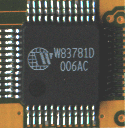The Card
Unlike some of the other ASUS GeForce cards we have seen, the V6800/64 is essentially the NVIDIA reference design, with one addition (we will talk about that later). The layout of the card is card is very similar to the layout of the older ASUS V6600 SDRAM card, also based on a reference design. One difference we noted when comparing the ASUS card to the other 64 MB GeForce reviewed, the SUMA Platinum 64 MB GeForce, was that ASUS choose not to use the AGP-Pro standard incorporated in the SUMA card. This makes sense for two reasons. First, very few motherboards include the AGP-Pro section of the AGP slot, making the AGP-Pro extension useless in most cases. Secondly, this extension only adds more cost to the card, as more PCB is used and additional lines for power must be implemented. Overall, it seems that ASUS made a wise choice by excluding AGP-Pro standard from the V6800/64. In actuality, a 64 MB card will only draw slightly more power than a 32 MB card, meaning that if your system works with at 32 MB GeForce you should have no problem with the 64 MB GeForce. Not only does the card work flawlessly on a regular AGP slot, it also prevents consumers from being worried that their motherboard will not provide the card with enough power.
Also noteworthy of the board layout is the abandonment of the proprietary board design found on all V6x00 cards besides the SDRAM model. The V6x00 Pure and Deluxe models both incorporate a special design manufactured by ASUS in order to permit these cards to carry powerful SGRAM chips as well as advanced video functions, such as video-input. It is possible that ASUS is doing what they did with the V6600 series, by releasing a reference board design to hit the market first and then releasing a "deluxe" version with all the additional features. However, with new products on the horizon it seems pointless to produce such a card. This keeps costs down as well, as a V6800/64 with video in and out would cost more than a fair share of money. It is also questionable if any memory manufacturer is making 8 megabyte density DDR SGRAM chips for mass production; it seems unlikely, leaving the specialized design RAM-less.
 One
thing that the V6800/64 does add that is not seen on reference design boards
is hardware monitoring, a very neat and useful feature. By incorporating the
same Winbond W83781D chip found on the other V6x00 cards (with exception to
the SDRAM model) on the back of the card, ASUS was able to provide not only
temperature readings but also fan RMP monitoring as well as AGP voltage monitoring.
This feature turns out to be a very useful tool, leaving us to dream of other
manufactures incorporating such a simple device.
One
thing that the V6800/64 does add that is not seen on reference design boards
is hardware monitoring, a very neat and useful feature. By incorporating the
same Winbond W83781D chip found on the other V6x00 cards (with exception to
the SDRAM model) on the back of the card, ASUS was able to provide not only
temperature readings but also fan RMP monitoring as well as AGP voltage monitoring.
This feature turns out to be a very useful tool, leaving us to dream of other
manufactures incorporating such a simple device.
The SDRAM chips used on the card are the same chips found on the SUMA Platinum 64 MB GeForce. It turns out that while the RAM is only of type SD, the Hyundai chips, rated at 6 ns, are highly overclockable and perform well on tests. The reason that the commonly used Infineon chips found on all 32 MB DDR GeForce cards are not used on the 64 MB cards seems to be that Infineon currently does not produce these chips with a density high enough to fit 64 MB of the RAM on the card. As it turns out, this change is good simply due to the fact that our overclocking success with the Hyundai SDRAM chips has been much better than the Infineon SGRAM chips. To see additional information why the 64 MB of on card RAM is so crucial to performance, please check out our 64 MB GeForce review.
The GPU is cooled via a hardware monitoring fan attached to the GPU via thermal grease. ASUS has always done a good job at adding just the right amount of the heat conductive material, meaning that the card is being cooled the best it can by the smallish fan. It is refreshing to see a company consistently use thermal grease to aid in cooling. Many times this detail is skipped due to the difficulty encountered by putting the correct amount of the goop on, leaving cards not cooled to their fullest potential.












0 Comments
View All Comments